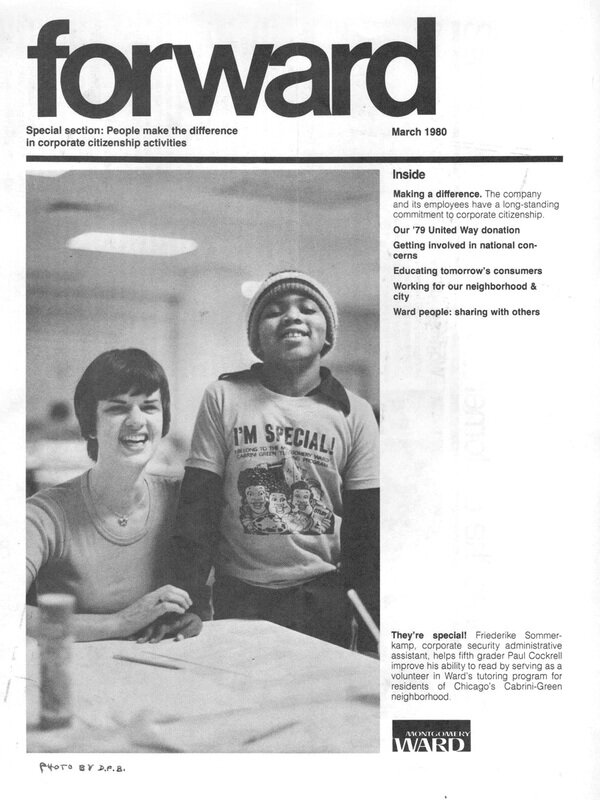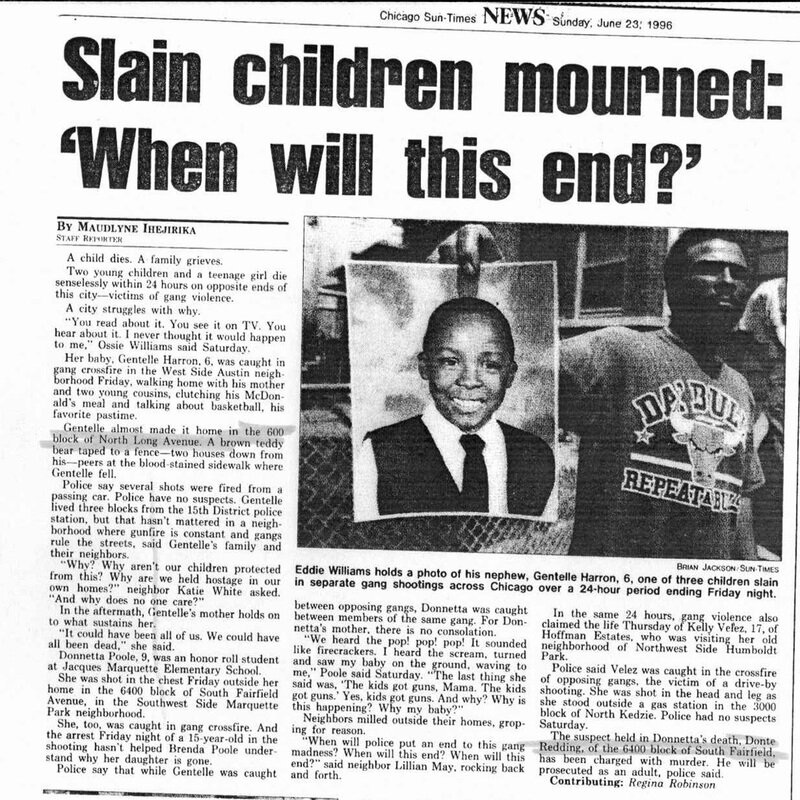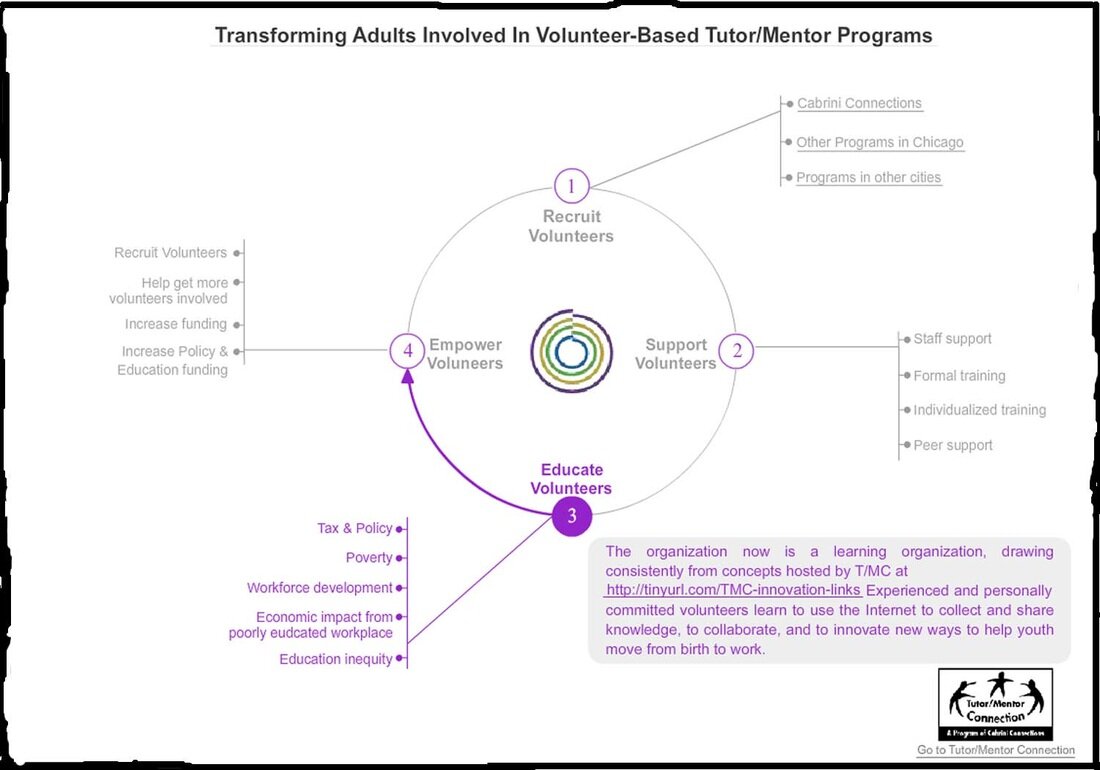The Start of the Story
I-Open saw some photos I've posted from my past 40 years involvement in tutoring/mentoring and asked me to write and article about how I got started as a volunteer tutor/mentor in 1973 and how I've grown to take on the advocacy roles I now am passionate about.
Intelligence To Innovate
|
My story starts with my love of history, which I studied in college, then the three years I served in the U.S. Army, where my specialty was “intelligence gathering”. Both experiences involve collecting available information and using it to innovate solutions to problems.
I came to Chicago in 1973 to become a retail advertising copywriter with the Montgomery Ward corporate headquarters. I had not studied business or advertising in college, so had to apply my “intelligence gathering” habits to learn my craft by borrowing ideas from others. |
|

So I ended up sitting next to a 4th grade boy named Leo, on a Tuesday evening in September 1973. That's Leo in the photo (Shown left). We met each week right after work. On many days, I did not want to go to tutoring, due to having had a long work day. Yet I always did, and always felt really good after our sessions ended. Leo was a big reason for that. Another was that I connected with a group of volunteers who played basketball once a week. I joined them and began to make new friends, while playing a sport I loved.
At the end of the first year Leo's Mom said, “He talks about you all the time. You need to be his tutor again next year.” At the same time, I was also recruited to be part of the committee of employee volunteers who organized the program each year.
At the end of the second year, as the committee of volunteers was sitting in an outdoor cafe, getting ready to start planning the coming school-year's activities, Roger Kennedy, who had been leading the program, and doing most of the work, for the previous three years, launched the meeting by saying, “I'm going to Europe and not coming back for two years.”
Each of us immediately recognized that someone else would need to take on the responsibility of leading the program. No one volunteered. Roger and I had argued during the year about the loose planning process of the committee, so Roger said, “Dan talks the most. He should be the new leader.”
No one disagreed.
So I entered the new school year in August 1975 as the volunteer leader of a tutoring program that already had 100 pairs of 2nd to 6th grade kids and volunteers meeting weekly from 5:15 p.m. to 6 p.m. on Tuesday and Wednesday evenings.
The first thing I did was get Roger to write up a history of what he had been doing and why. Then we convinced the company to provide a small room to serve as the Tutoring Program Office. Up until then, each leader kept his own program records in his/her own office. By getting a central office space, I was able to gather the records of every other leader into one location. I began reading these (collecting intelligence) and started to form my own vision for the future, based on what I could learn and borrow from past leaders and other volunteers.
I put this into my own plan for the tutoring program's future and asked for support from the local schools, the Chicago Housing Authority, and leaders at Montgomery Ward. Then I began to implement the plan.
Life Cycles
Again, this is a habit of using available intelligence to improve work process and results.
Engagement Sustains
Due to downsizing that started in 1980 when Wards closed its $2 billion catalog business, volunteers moved to different companies. Many stayed involved with the tutoring program, and started to recruit other volunteers from their new companies. While 90% of the 100 volunteers with the program in 1975 were Montgomery Ward employees, only 10% of 350 volunteers active in 1989-90 were employees. The rest came from nearly 100 other companies in the Chicago region.
Throughout this time the tutoring program was a volunteer organization led by Montgomery Ward employees. Up until 1978 there was no paid staff. From then till 1990 the paid staff consistent of part time college students recruited from Moody Bible Institute. I set up a program asking for a 3 year commitment. So by the third year a student had a pretty good idea of what was needed to help volunteers like myself lead the program. That volunteer would then be the 'trainer' for the new staff member starting his/her first year. This freed me from needing to train new staff.
This was critically important because my day job leading corporate advertising often meant starting in meetings at 6:30 a.m. and continuing until 7 or 8 p.m. Without finding ways to recruit and delegate roles to others and maximize the contributions of paid staff, I could not have continued to lead, and grow, the program. As it was I spent my lunch hour, evenings and Saturday and Sunday mornings in the tutoring office, as well as a week long vacation every spring.
While employees led the program, it was strongly supported at Wards.
Development
|
In the 1980s my advertising roles made me a key figure in planning meetings that included senior executives from marketing and merchandise divisions of the company. Often the meetings came to an end when someone from corporate security would call and say “Dan, there are kids in the lobby. Can you come and open the tutoring center?”
It required tremendous support from company leaders for me to be able to leave these meetings to engage in my volunteer occupation.
I emphasize this because I did not start volunteering with an intention of becoming a leader of a volunteer based tutor/mentor program.
|
"I did not start volunteering with an intention of becoming a leader of a volunteer based tutor/mentor program. It grew over many years and was rewarded by many experiences and relationships." |
My commitment and knowledge grew through the annual cycle of recruiting kids/volunteers in the fall, supporting them each week during the school year, finding replacements for those who dropped out, then recruiting a new team of volunteers in the spring to help me repeat the cycle in the following year.
Smarter Together
I had begun to reach out to leaders of other area tutoring programs in my first year on the program committee. During my first year of leading the program an executive at Wards said “Dan, you don't know much about leading a tutor/mentor program. Why don't you find others who run programs, invite them to lunch, and see what you can learn from them. We'll pay.”
So I started reaching out to other programs, inviting them to lunch, where we each shared our handbooks, tutoring strategies, visions, and frustrations. We began to bond, recognizing that only the people who have the “buck stops with us” responsibility of leading a program really understand what a burden this is. By connecting with peers I energized my own batteries each year. I gained new ideas that I introduced into my own program. I expanded my network of friends.
We began to organize an annual tutor training event in September, recognizing that each program did a volunteer training, and that by working together we could offer better training with less work involved. As we repeated these we began to reach out to find others who might attend, and I begin to realize that no one had a master database of tutor/mentor programs operating in Chicago, thus, no one could invite every other program to gather and share ideas.
As I began seeking programs to invite to our lunch meetings, I started building a database of programs. I soon learned, that the only one who could effectively invite others to gather and share ideas was the one with the database. And, the database needed to be updated regularly.
I also had help from many volunteers over the years who offered me leadership and planning advise. One of the most important was a team from the National Right to Read Program, who in the 1976-77 period encouraged me to create a written plan showing goals and accomplishments. I began to do this and have never started a new year from scratch. Each new year always builds off of what we did, or tried to do, in the previous year. Using desk top publishing, which became available to me in the early 1980s through my advertising work, the creation of such a plan was greatly simplified.
Patterns
I also began to recognize a pattern in the media. While there were incidents of violence in Chicago on a regular basis, only occasionally were these given front page, or editorial attention. While the stories would often say where the bad news took place, and often quote parents or youth saying “we need more activities for our kids”, the media did not work like advertising, calling on readers to be volunteers and donors helping tutor/mentor programs grow in the neighborhoods where bad news was happening. Furthermore, the media only were pointing to the neighborhood where an incident took place, not talking about all other neighborhoods in the city which had the same problem. Nor were they pointing to a list of all the tutor/mentor programs in the city. Instead, when they did point to a youth organization to support, they pointed to brand name organizations like the Boys & Girls Clubs or the Big Brothers program.
In advertising we were in the paper three times a week and we supported all 400 of our stores.
By 1990 I was looking for an opportunity to transition from my corporate advertising role to a role where I could help tutor/mentor programs grow in all parts of Chicago. My 17 years of involvement and day-to-day leadership at turned me from someone who “could afford one hour a week” to someone who spent 10-15 hours a week and often more doing the work necessary to help a single program grow.
Wards gave me that opportunity in 1990, and with the help of volunteers and youth in the tutoring program, we created a nonprofit Cabrini Green Tutoring Program, Inc. with myself in a paid position of Executive Director.
Since we started with no money, I also took on a part time role as a Loaned Executive for the United Way Crusade of Mercy, representing the Quaker Oats Company who had been supporting the tutoring program with volunteers and in-kind donations since 1980. I spent four years as a LE while we grew the Cabrini-Green Tutoring Program, and later as I launched the Cabrini Connections, Tutor/Mentor Connection. This was valuable “intelligence gathering” for me because I saw how corporate executives served as Chief Crusaders who encouraged other CEOs to organize annual company fund raising campaigns. I have tried to duplicate this leadership model In the strategies of the Tutor/Mentor Connection.
Life-Lines of Public Service
I've also not shown the journey from 1990 to 2015 which has had many ups and downs and led me to create the Tutor/Mentor Institute, LLC in mid 2011.
Volunteer Leadership Cycles
A 2007 intern from Hong Kong University created a different version of this idea, which was later revised by a 2010 intern from South Korea. You can see the most recent version here.
Around The Circle
If I can help programs in Chicago or other cities recruit volunteers from different business backgrounds, and keep them involved multiple years, some of these volunteers will become leaders and help those programs find the talent, dollars and ideas needed to help programs grow.
If I can connect volunteers from different programs, in multiple cities, in a portal, or a network of linked portals, where they find ideas that help them in their own programs, I feel we can begin to encourage formation of teams of volunteers representing different programs, and different cities, industries, colleges, etc., who will work in virtual teams that enlist reinforcements from their industries and support the growth of all tutor/mentor programs in a city, not just the programs each volunteer is part of.
More than 100,000 people have been involved in tutor/mentor programs every year for the past 20 to 30 years. This represents an army of potential talent and leadership that could be working like a “virtual corporate office” to help high quality, constantly improving tutor/mentor programs grow in every poverty neighborhood of the country.
This is not an idea that I was thinking about in 1973.
It's an idea that grew over my first 20 years and I've continued to develop over the next 20 years.
|
Author, Daniel F. Bassill, D.H.L., President & Founder, Tutor/Mentor Institute, LLC, has been leading a volunteer-based tutor/mentor program in since 1974. Today's article focuses on the questions he has been asking in his own on-going efforts to help Chicago youth benefit from well-organized, long-term, tutoring/mentoring programs.
Learn about Tutor/Mentor Institute HERE. Subscribe to Tutor/Mentor Institute weekly blog articles HERE. |
Become a Conference and Tutor/Mentor Institute, LLC Sponsor HERE.
Ensure education, economic and workforce development services such as knowledge sharing, communications and engagement for a network of community and economic developers. Send your donation to I-Open by clicking on the secure PayPal donate button below.













 RSS Feed
RSS Feed